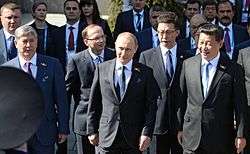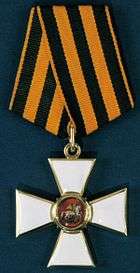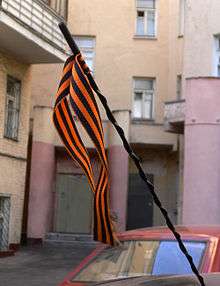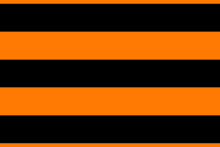Ribbon of Saint George
| Ribbon of Saint George Георгиевская лента | |
|---|---|
|
Flag of the Saint George Ribbon. Often used by pro-Russian protestors in Ukraine | |
| Information | |
| Date of origin | Order of Saint George, established in 1769 |
.svg.png)
The ribbon of Saint George (also known as Saint George's ribbon and the Georgian ribbon; Russian: Георгиевская лента, Georgiyevskaya lenta) is a widely recognized military symbol in Russia. The ribbon consists of a black and orange bicolour pattern, with three black and two orange stripes. It appears as a component of many high military decorations awarded by the Russian Empire, the Soviet Union, and the current Russian Federation.
During Soviet times, the ribbon held no public significance.[1] The symbol was revived in Russia in 2005 as a response to the pro-democratic Orange Revolution in Ukraine.[1][2][2] That year, Russian state media along with youth organizations launched the campaign ahead of World War II memorial celebrations.[1] It was associated with units who were awarded the collective Guard battle honours during the conflict, due to the usage of the color scheme in the Great Patriotic War victory medal awarded to all personnel, civilian or military, who aided the war effort.
In Russia, the ribbon of Saint George is also used by civilians as a patriotic symbol and as a symbol of public support to the Russian government, particularly since 2014.[3] In Ukraine and the Baltic states (Estonia, Latvia and Lithuania), the symbol has become widely associated with Russian nationalist and separatist sentiment.[4]
History
The Georgian ribbon emerged as part of the Order of Saint George, established in 1769 as the highest military decoration of Imperial Russia (and re-established in 1998 by Presidential decree signed by then President of Russia Boris Yeltsin). While the Order of Saint George was normally not a collective award, the ribbon was sometimes granted to regiments and units that performed brilliantly during wartime and constituted an integral part of some collective battle honours (such as banners and pennants). When not awarded the full Order, some distinguished officers were granted ceremonial swords, adorned with the Georgian ribbon.[5]
In 1806, distinctive Georgian banners were introduced as a further battle honour awarded to meritorious Guards and Leib Guard regiments. The pike on which these flags were mounted was topped by the Cross of Saint George and adorned with 4,44 cm wide Georgian ribbons. It remained the highest collective military award in the Imperial Russian Army until the Revolution in 1917. It is worth noting that the tsarist version was yellow and black, not orange and black like the revived Soviet version.[6]
The symbolism of the orange and black (or yellow and black) is thought to represent fire and gunpowder of war, or the death and resurrection of Saint George, or the colours of the original Russian imperial coat of arms (black eagle on a golden background).[6]
The title of the Soviet Guards was first introduced on 18 September 1941 in accordance with the decision of the Headquarters of the Supreme Commander-in-Chief (Russian: Ставка Верховного Главнокомандующего, Stavka, Verkhovnogo Glavnokomanduyushchego) and by the order No. 308 of the People's Commissar of Defense for the distinguished services during the Yelnya Offensive. The 100th, 127th, 153rd and 161st Rifle Divisions were renamed into the 1st, 2nd, 3rd and 4th Guards Divisions, respectively. The units and formations nominated for the Soviet Guard title received special Guards banner in accordance with the decision of the Presidium of the Supreme Soviet of the USSR. On 21 May 1942, the Presidium of the Supreme Soviet of the USSR introduced Guards ranks and Guards badges to be worn of the right side of the chest. Both included the Georgian ribbon pattern. In June 1943, they introduced the Guards Red Banners for the land forces and in February 1944 - for the naval forces. Georgian ribbons adorned the banners exactly as in the 19th century.[6]


Established on 8 November 1943, the Order of Glory (Orden Slavy) was an order of the Soviet Union. It was awarded to non-commissioned officers and the rank-and-file of the armed forces, as well as to junior lieutenants of the air force, for bravery in the face of the enemy. The ribbon of the Order was orange with three black stripes - the same as that of the Cross of Saint George.
One of the most honourable medals in the Soviet Union, the medal "For the Victory over Germany" (Russian: За победу над Германией, Za pobedu nad Germaniyey) also features Saint George stripes. It was awarded to all the soldiers and officers who participated in the Eastern Front campaigns, and was the first award to be universally granted to all the veterans, for the most part, right after the end of the war.
The ribbon – along with the Russian tricolored flag and the Russian Navy Ensign – was also used by the anti-Soviet Russian Liberation Army that fought alongside Nazi Germany during World War II.[1]
2005 Georgievskaya Lenta Action
In 2005, the 60th anniversary of Victory Day, news agency RIA Novosti and a youth civic organization launched a campaign that called on volunteers to distribute ribbons in the streets ahead of Victory Day.[1][5] Since then the ribbon is worn by civilians in Russia and other former republics of the Soviet Union as an act of commemoration and remembrance.[5] For the naming of the ribbons the diminutive form is used: георгиевская ленточка (georgiyevskaya lentochka, “small George ribbon”).[5] Since 2005 the ribbon is distributed every year all over Russia, and around the world in the preparation for 9 May and is on that day widely to be seen on wrists, lapels, and cars.[2][5] The motto that goes with it is "We remember, we are proud!"[5]
Yulia Latynina and other journalists have speculated the Russian government introduced the ribbon as a public relations response to the 2004 Orange Revolution in Ukraine in which demonstrators had adopted orange ribbons as their symbol.[1][2]
Use during the Ukrainian crisis

During events of 2014 in Ukraine it was used by Antimaidan activists and pro-Russian population of Ukraine (especially in the south-east regions) as a symbol of pro-Russian and separatist sentiment.[7][8] The ribbon is also worn by members of the Donbass People's Militia paramilitary group. Euromaidan activists sometimes make derogatory reference to the Ribbon of Saint George as the "Colorado Ribbon", as the colors of the ribbon coincide with the colors of a Colorado potato beetle.[8][9]
In Kirovohrad, a decision was made by veterans to ban the symbol from Victory Day celebrations "in order to prevent provocations between the activists of different movements". Instead, only Ukrainian state symbols would be used.[10] In Cherkasy, authorities urged veterans and supporters not to wear the ribbon or any other party symbols.[11]
The Ukrainian government replaced the ribbon with a red-and-black poppy, like those associated with Remembrance Day in Western Europe in 2014,[1][12] red and black also being the colours used by the Ukrainian Insurgent Army during the conflict.
A female police captain from Kharkiv was fired "for stupidity" for giving out the ribbon at the police station on 23 February 2015, the day which until 2014 was celebrated (in Kharkiv) as Defender of the Homeland Day.[13]
Belarus
On 5 May 2014, the Belarusian Republican Youth Union encouraged activists not to use the ribbon. Other officials reported that the decision not to use the symbol was related to the situation in Ukraine, "where the ribbon is used by militants and terrorists".[14] In time for Victory Day 2015, the ribbon's colors were replaced by the red, green and white from the Flag of Belarus.[15] But the President of Belarus Alexander Lukashenko arrived on 7 May 2015 in Moscow with a Saint George ribbon combined with the flag of Belarus placed on the lapel of his jacket, thus showing his personal positive attitude to the ribbon.
Canada
During preparation for the first Victory Day parade in the Canadian city of Winnipeg on 10 May 2014, the Russian embassy distributed Ribbons of Saint George to participants. The move was considered controversial in view of the ongoing events in Ukraine with the Ukrainian Canadian Congress calling the ribbon a "symbol of terrorism."[16]

Kazakhstan
Some parties made statements intended to discourage the use of the ribbon in Kazakhstan in 2014 for Victory Day celebrations, suggesting that red (of the Red Army) and turquoise (the national color of Kazakhstan) should be used instead.[17] However, no official authority issued any comments.
Latvia
The government of Latvia proposed the ban on the use of any Ribbons of Saint George by law on May 2014; earlier, Latvia imposed a ban on the use of all Soviet symbols at public events.[18]
Lithuania
The ban on similar grounds to that in Latvia has been discussed.[19]
Russian nationalist and government loyalist symbol
The ribbon has been adopted by Russian nationalist and government loyalist groups. During the 2011–13 Russian protests, protestors demonstrating against electoral fraud in the 2011 elections carried white ribbons. Supporters of Putin would counter-protest wearing Saint George's ribbon.[20] On 28 April 2016, a group of people from the National Freedom Movement[21] wearing St. George ribbons attacked a school competition organized by the Memorial society, pouring toxic solution of Brilliant Green to writer Ludmila Ulitskaya and other guests and assaulting a journalist.[22][23] The Russian ultranationalist group National Liberation Movement (NOD) has adopted the orange-black flag as its symbol.[24]
Gallery
 Saint George Standard of the Life Guard Cuirassier Regiment 1817
Saint George Standard of the Life Guard Cuirassier Regiment 1817 Imperial Cross of Saint George 3rd class 1807 - 1917 (enlisted award)
Imperial Cross of Saint George 3rd class 1807 - 1917 (enlisted award)
 Soviet Order of Glory 3rd class
Soviet Order of Glory 3rd class Russian Federation Order of Saint George IV class
Russian Federation Order of Saint George IV class Guards Badge of the Armed Forces of the Russian Federation
Guards Badge of the Armed Forces of the Russian Federation Beret badge with ribbon of St George of a Russian Federation Guards unit
Beret badge with ribbon of St George of a Russian Federation Guards unit Ribbon of Saint George on a car antenna, Moscow, May 2008
Ribbon of Saint George on a car antenna, Moscow, May 2008 Flag of the Saint George Ribbon
Flag of the Saint George Ribbon Victory Day 2014 in Donetsk, Ukraine, people with Saint George ribbons
Victory Day 2014 in Donetsk, Ukraine, people with Saint George ribbons Pro-Russian separatist Vostok Battalion member wearing a Saint George ribbon armband
Pro-Russian separatist Vostok Battalion member wearing a Saint George ribbon armband A man with Saint George Ribbon, Sweden, May 2014
A man with Saint George Ribbon, Sweden, May 2014 Soviet postage stamp from 1985, on the 40th anniversary of victory of World War II
Soviet postage stamp from 1985, on the 40th anniversary of victory of World War II
See also
| Wikimedia Commons has media related to Ribbon of St. George. |
References
- 1 2 3 4 5 6 7 "Ukraine breaks from Russia in commemorating victory". Kyiv Post. Retrieved 8 May 2015.
“In the 1960-70s there were no St. George’s Ribbons seen during the Victory Day parades. If someone showed up with a ribbon, it would be a violation.
- 1 2 3 4 Russia awash with symbols of WW2 victory, BBC News 8 May 2015
- ↑ Kashin, Oleg (1 May 2015). "Hunting swastikas in Russia". OpenDemocracy.net.
- ↑ Karney, Ihar; Sindelar, Daisy (7 May 2015). "For Victory Day, Post-Soviets Show Their Colors -- Just Not Orange And Black". Radio Free Europe/Radio Liberty.
- 1 2 3 4 5 6 Anatoly Korolev and Dmitry Kosyrev (11 June 2007). "National symbolism in Russia: the old and the new". RIA Novosti. Retrieved 23 February 2015.
- 1 2 3 Alexei Rudevich (25 April 2014). 5 фактов о георгиевской ленте [5 Facts about the Saint George Ribbon]. Russia7 (in Russian). Retrieved 23 February 2015.
- ↑ Bigg, Claire (May 6, 2014). "Kyiv Ditches Separatist-Linked Ribbon As WWII Symbol". Radio Free Europe/Radio Liberty. Retrieved 2014-05-09.
- 1 2 Sindelar, Daisy (April 28, 2014). "What's Orange and Black and Bugging Ukraine?". Radio Free Europe/Radio Liberty. Retrieved 18 May 2014.
Ukraine’s Reins Weaken as Chaos Spreads, The New York Times (4 May 2014)
(Ukrainian) Lyashko in Lviv poured green, Ukrayinska Pravda (18 June 2014) - ↑ Активистка Майдана: "Это я сожгла три колорадские ленты" (in Russian). Moskovskij Komsomolets. March 30, 2014. Retrieved 13 April 2014.
- ↑ "Кировоградские ветераны отказались от георгиевских лент на 9 мая : Новости УНИАН". Unian.net. 2014-04-23. Retrieved 2014-05-09.
- ↑ "Председатель Черкасской ОГА призвал отказаться на 9 мая от георгиевских лент : Новости УНИАН". Unian.net. 2014-04-26. Retrieved 2014-05-09.
- ↑ Yaffa, Joshua. "Vladimir Putin's Victory Day in Crimea". The New Yorker. Retrieved 2014-05-09.
- ↑ Anya Bodnar (23 February 2015). Капітана міліції у Харкові звільнили за привітання із георгіївською стрічкою [Police Captain in Kharkiv fired for handing out Ribbon of Saint George] (in Ukrainian). Ukrainian Press. Retrieved 23 February 2015.
- ↑ "Георгиевская лента напугала Лукашенко". Retrieved 12 August 2016.
- ↑ "Russians embrace Kremlin-backed WWII ribbon". Retrieved 12 August 2016.
- ↑ "Pro-Russia parade planned for city riles local Ukrainians". WinnipegFreePress. 9 May 2014. Retrieved 9 May 2014.
- ↑ Черно-оранжевые ленты не будут использоваться в ходе празднования Дня Победы в Казахстане. (in Russian). Dialog.kz. Retrieved 16 February 2015.
- ↑ "Latvia proposes ban on Russian St. George's ribbon". Retrieved 10 September 2014.
- ↑ "Lithuanian faction: St. George Ribbon a symbol of 'Russian aggression and imperialist ambitions'". Retrieved 12 August 2016.
- ↑ Malgin, Andrei (April 16, 2014). "The Black and Orange Ribbon of Putin's Army". The Moscow Times.
- ↑ "В Москве облили зеленкой Улицкую" (in Russian). Lenta.ru. 28 April 2016. Retrieved 10 May 2016.
- ↑ "Crowd wearing nationalist symbols attacks children's school competition organized by historical society Memorial — Meduza". Retrieved 12 August 2016.
- ↑ "Meduza correspondent assaulted by member of crowd disrupting Memorial society young scholar awards — Meduza". Retrieved 12 August 2016.
- ↑ "Putin's ultranationalist base takes aim at the West". Retrieved 12 August 2016.
.jpg)